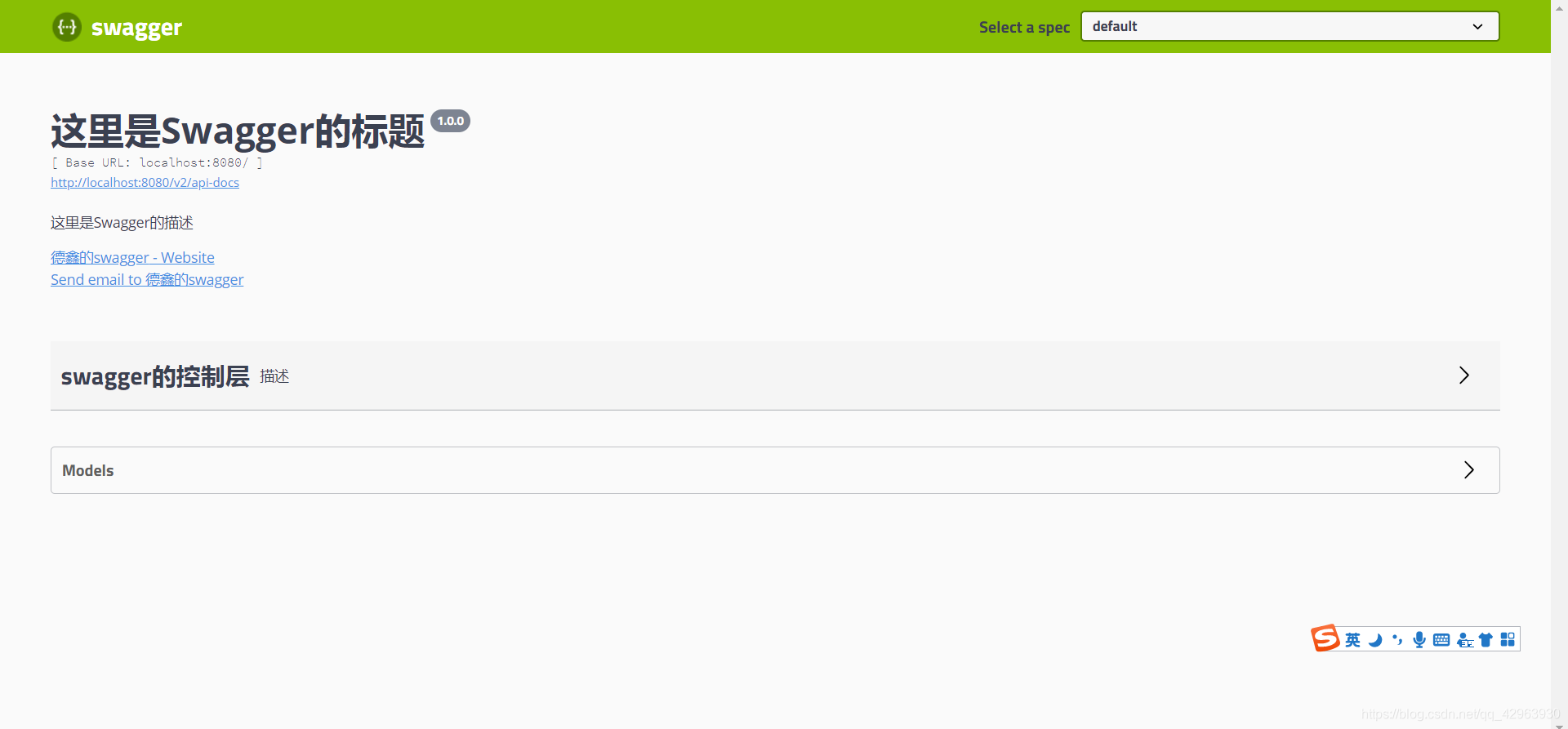一、swagger的主要是用来干什么
swagger已经不算什么很新的框架了,基本上各大项目组都在用。主要作用就是很多人员会抱怨别人写的接口文档不规范,不及时更新。但是当自己写的时候确实最烦去写接口文档。
所以接口文档可以实时动态生成就不会出现上面问题
话不多说,直接开整
二、springboot整合swagger2
1、创建好一个springboot项目,加入依赖
<dependency>
<groupId>org.springframework.boot</groupId>
<artifactId>spring-boot-starter-web</artifactId>
</dependency>
<dependency>
<groupId>io.springfox</groupId>
<artifactId>springfox-swagger2</artifactId>
<version>2.9.2</version>
</dependency>
<dependency>
<groupId>io.springfox</groupId>
<artifactId>springfox-swagger-ui</artifactId>
<version>2.9.2</version>
</dependency>
2、Swagger2配置
只需要开发者自己提供一个Docket的Bean即可。
例如最简单的:
package com.dexin.config;
import com.google.common.base.Predicate;
import org.springframework.context.annotation.Bean;
import org.springframework.context.annotation.Configuration;
import springfox.documentation.builders.ApiInfoBuilder;
import springfox.documentation.builders.RequestHandlerSelectors;
import springfox.documentation.service.ApiInfo;
import springfox.documentation.service.Contact;
import springfox.documentation.spi.DocumentationType;
import springfox.documentation.spring.web.plugins.Docket;
import static com.google.common.base.Predicates.or;
import static springfox.documentation.builders.PathSelectors.regex;
/**
* @author: 德鑫
* Description:
* @Date: 2021/03/03
*/
@Configuration
public class SwaggerConfig {
@Bean
public Docket getDocket() {
return new Docket(DocumentationType.SWAGGER_2)
.apiInfo(swaggerDemoApiInfo())
.select()
// 可以通过apis()方法设置哪个包中内容被扫描
.apis(RequestHandlerSelectors.basePackage("com.dexin.controller"))
// .apis(not(withMethodAnnotation(NotIncludeSwagger.class)))
.paths(allowPaths())
.build();
}
private Predicate<String> allowPaths(){
return or(
regex("/People/.*")
);
}
private ApiInfo swaggerDemoApiInfo() {
return new ApiInfoBuilder()
.contact(new Contact("德鑫的swagger", "http://www.dexinxxx.com", "xxx@163.com"))
//文档标题
.title("这里是Swagger的标题")
//文档描述
.description("这里是Swagger的描述")
//文档版本
.version("1.0.0")
.build();
}
}
3、通过@EnableSwagger2注解启用Swagger2
package com.dexin;
import org.springframework.boot.SpringApplication;
import org.springframework.boot.autoconfigure.SpringBootApplication;
import springfox.documentation.swagger2.annotations.EnableSwagger2;
@SpringBootApplication
@EnableSwagger2
public class Swagger2Application {
public static void main(String[] args) {
SpringApplication.run(Swagger2Application.class, args);
}
}
输入 http://localhost:8080/swagger-ui.html

三、swagger2常见的注解
1、@Api注解可以用来标记当前Controller的功能。
2、@ApiOperation注解用来标记一个方法的作用。
3、@ApiImplicitParam注解用来描述一个参数,可以配置参数的中文含义,也可以给参数设置默认值,这样在接口测试的时候可以避免手动输入。
4、如果有多个参数,则需要使用多个@ApiImplicitParam注解来描述,多个@ApiImplicitParam注解需要放在一个@ApiImplicitParams注解中。
5、@ApiModel 是类上注解,主要应用Model,也就是说这个注解一般都是写在实体类上。
-value:名称
-description:描述
6、@ApiModelProperty可以用在方法或属性上。用于当对象作为参数时定义这个字段的内容。
7、@ApiIgnore。@ApiIgnore用于方法或类或参数上,表示这个方法或类被忽略
那就把我自己写的一些测试代码放到上面来吧: 上面的SwaggerConfig
package com.dexin.controller;
import com.dexin.anno.NotIncludeSwagger;
import io.swagger.annotations.*;
import org.springframework.web.bind.annotation.GetMapping;
import org.springframework.web.bind.annotation.PostMapping;
import org.springframework.web.bind.annotation.RequestMapping;
import org.springframework.web.bind.annotation.RestController;
import java.util.Objects;
/**
* @author: 德鑫
* Description:
* @Date: 2021/03/03
*/
@RestController
@RequestMapping("/People")
@Api(tags = {"swagger的控制层"},description = "描述")
public class SwaggerController {
@ApiOperation(value="接口描述",notes = "接口提示信息")
@PostMapping("/getPeople")
@ApiImplicitParam(name = "id",value = "id",required = true,paramType = "query",dataType = "string")
public People getPeople(Long id, String name){
System.out.println(id);
People peo = new People();
peo.setId(id);
peo.setName(name);
peo.setAddress("海淀");
return peo;
}
@NotIncludeSwagger
@GetMapping("/getPeople2")
public People getPeople2(Long id , @ApiParam(value="姓名",required = true) String name){
People peo = new People();
peo.setId(id);
peo.setName(name);
peo.setAddress("朝阳");
return peo;
}
}
@ApiModel(value = "人类",description = "描述")
class People {
private Long id;
@ApiModelProperty(value = "姓名",name = "name",required = true,example = "张三")
private String name;
private String address;
public Long getId() {
return id;
}
public People setId(Long id) {
this.id = id;
return this;
}
public String getName() {
return name;
}
public People setName(String name) {
this.name = name;
return this;
}
public String getAddress() {
return address;
}
public People setAddress(String address) {
this.address = address;
return this;
}
@Override
public String toString() {
return "People{" +
"id=" + id +
", name='" + name + '\'' +
", address='" + address + '\'' +
'}';
}
@Override
public boolean equals(Object o) {
if (this == o) return true;
if (o == null || getClass() != o.getClass()) return false;
People people = (People) o;
return Objects.equals(id, people.id) &&
Objects.equals(name, people.name) &&
Objects.equals(address, people.address);
}
@Override
public int hashCode() {
return Objects.hash(id, name, address);
}
}
包括我们的自定义注解
package com.dexin.anno;
import java.lang.annotation.ElementType;
import java.lang.annotation.Retention;
import java.lang.annotation.RetentionPolicy;
import java.lang.annotation.Target;
/**
* @author: 德鑫
* Description:
* @Date: 2021/03/03
*/
@Target({ElementType.METHOD})
@Retention(RetentionPolicy.RUNTIME)
public @interface NotIncludeSwagger {
}
还有别忘了在我们项目的启动类上面添加 @EnableSwagger2 启动swagger2注解
好了就写到这里了。























 6万+
6万+











 被折叠的 条评论
为什么被折叠?
被折叠的 条评论
为什么被折叠?








